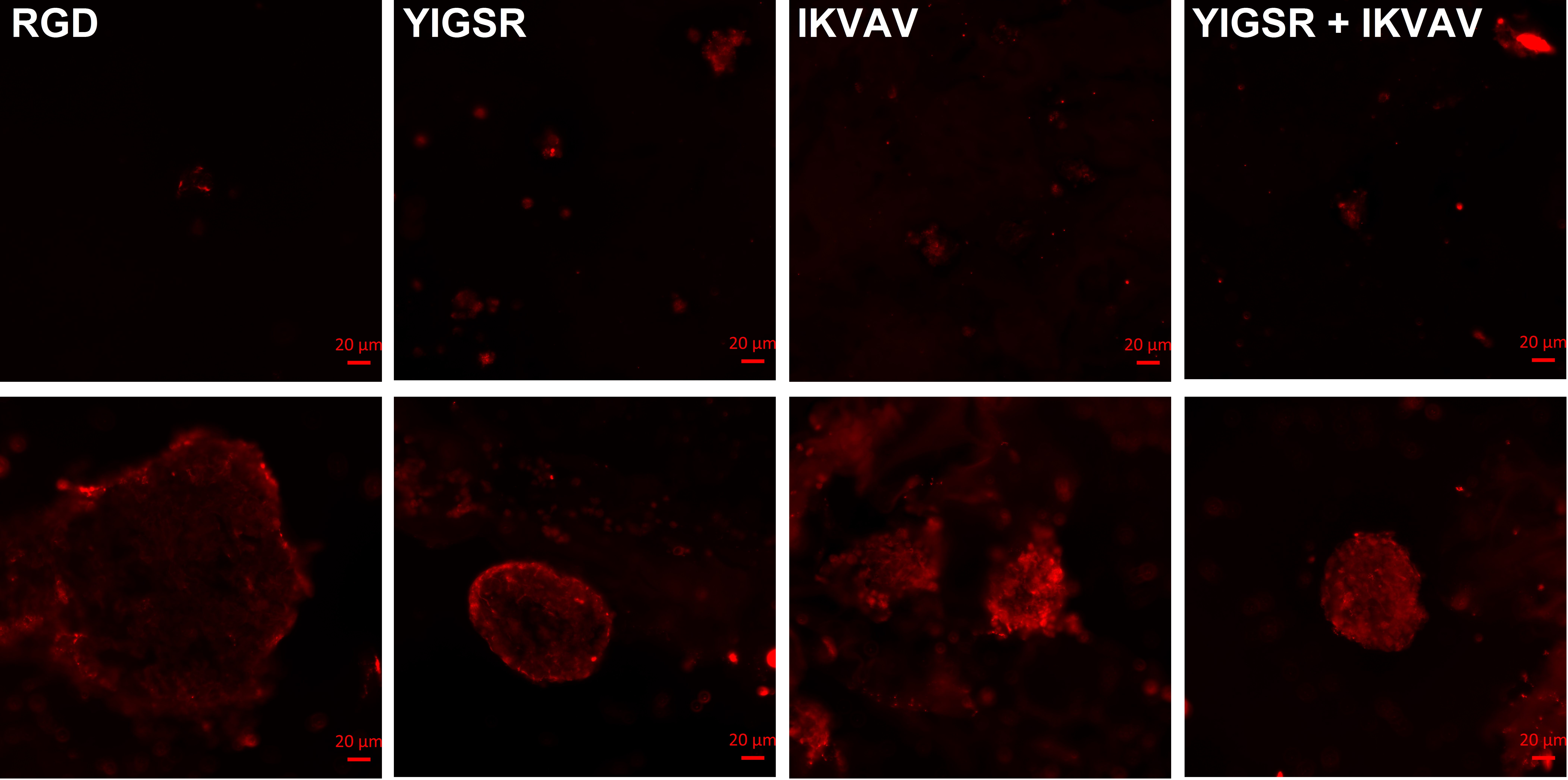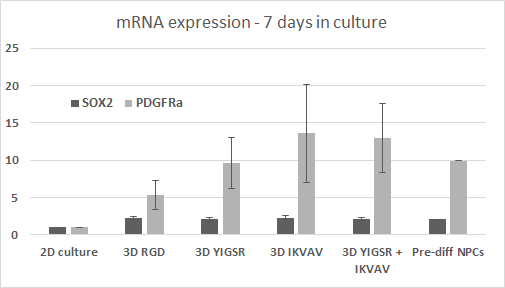Introduction: Many disorders of the central nervous system (CNS) cause extensive death of highly specialized oligodendrocytes. While endogenous neural stem/progenitor cells (NS/PCs) are recruited to diseased areas in the adult CNS, their differentiation and functional engraftment are limited [1]. In order to effectively employ NS/PC-based therapies in the clinic, it is imperative to develop strategies to direct differentiation efficiently. NS/PCs can differentiate into neurons, astrocytes and oligodendrocytes; however, this work focuses on oligodendrocyte-lineage (OL) differentiation. To better direct differentiation, we have modified hydrogels based on hyaluronic acid (HA), which mimic native CNS tissues, with adhesive peptides with the goal of identifying microenvironmental parameters that drive OL differentiation.
Materials and Methods: HA was modified with thiol groups and cross-linked with 4-arm PEG-maleimide. Peptides were conjugated to PEG arms [2],[3]. H9-derived NS/PCs were encapsulated and cultured in 3D HA hydrogels for up to 4 weeks in minimal medium. At 7 and 28 days, expression of OL markers was assessed using immunofluorescence imaging, flow cytometry and qRT-PCR.
Results and Discussion: After 1 and 4 weeks of 3D culture in a minimal medium with no added growth factors, NS/PCs showed increased expression in OL markers (e.g., platelet-derived growth factor receptor-A, PDGFR-A and CNPase) and decreased expression of markers for multipotency (e.g., Sox2) when compared to NS/PCs cultured on 2D surfaces coated with fibronectin I-based substrates (CELLstart, Life Technologies).

Addition of laminin I-derived adhesive peptides (YIGSR, IKVAV) to hydrogels appears to further promote OL differentiation. Expression of OL markers by NS/PC cultured in IKVAV/YIGSR-containing hydrogels with minimal medium resulted in PDGFR-A expression levels comparable to NS/PCs cultured in OL-differentiation promoting medium [4].

Transition to a medium promoting OL differentiation further enhanced PDGFR-A expression in hydrogel cultures. In contrast, incorporation of adhesive peptides containing the integrin-binding sequence RGD did not increase OL differentiation, but did increase cell number. Finally, culture in HA hydrogels increased NS/PC expression of the HA receptor CD44, when compared to 2D cultures.
Conclusions: HA hydrogels mimic the native spinal cord environment and present a novel method to increase regeneration in the spinal cord. Further, these gels are highly modifiable with adhesive and pro-differentiation peptides, and can be injected with NPCs directly in to injured spinal tissue. In sum, results demonstrate that HA-based hydrogels can be tuned to promote OL differentiation. In future studies, we will apply these hydrogels as injectable carriers for therapeutic delivery of NS/PCs into the spinal cord [5]. HA hydrogels are a promising tool to increase the efficiency of NS/PC differentiation towards oligodendrocytes and functional repair of demyelinated axons.
References:
[1] Miron VE, Kuhlmann T, Antel Jack P. JP. Cells of the oligodendroglial lineage, myelination, and remyelination. Biochim Biophys Acta - Mol Basis Dis. 2011;1812(2):184-193. doi:10.1016/j.bbadis.2010.09.010
[2] Mothe AJ, Tam RY, Zahir T, Tator CH, Shoichet MS. Repair of the injured spinal cord by transplantation of neural stem cells in a hyaluronan-based hydrogel. Biomaterials. 2013;34(15):3775-3783. doi:10.1016/j.biomaterials.2013.02.002
[3] Ding J, He R, Zhou G, Tang C, Yin C. Multilayered mucoadhesive hydrogel films based on thiolated hyaluronic acid and polyvinylalcohol for insulin delivery. Acta Biomater. 2012;8(10):3643-3651. doi:10.1016/j.actbio.2012.06.027.
[4] Hu B-Y, Du Z-W, Zhang S-C. Differentiation of human oligodendrocytes from pluripotent stem cells. Nat Protoc. 2009;4(11):1614-1622. doi:10.1038/nprot.2009.186
[5] Liang Y, Walczak P, Bulte JWM. The survival of engrafted neural stem cells within hyaluronic acid hydrogels. Biomaterials. 2013;34(22):5521-5529. doi:10.1016/j.biomaterials.2013.03.095